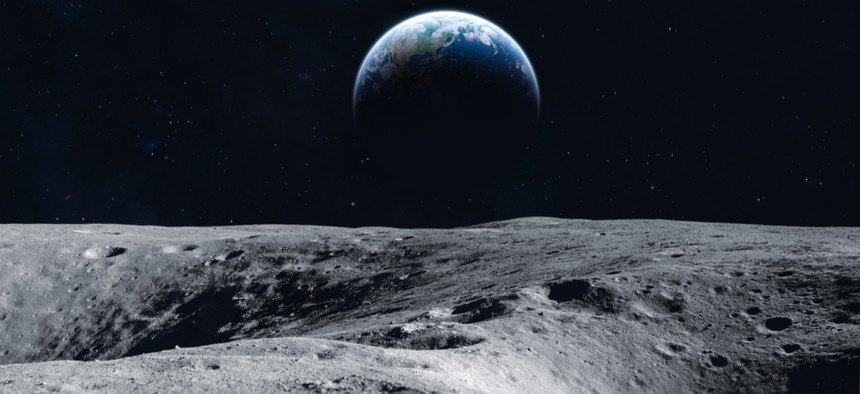How Humans Will Design the First Full-Time Habitat on the Moon

Dima Zel/Shutterstock
Skidmore, Owings & Merrill LLP (SOM), in partnership with the ESA and MIT, wants to accommodate research and maybe even tourism on the moon.
The first humans landed on the moon in 1969. Fifty years later, humans are figuring out how to live there.
Radiation, lack of breathable air, generating energy, and relying on rockets to transport building materials are among the challenges for humans settling on the moon. But it is possible to find solutions to these challenges, according to SOM Design Partner Colin Koop.
His firm has released a design for the first full-time human habitat on the lunar surface, in partnership with the European Space Agency (ESA) and the Massachusetts Institute of Technology (MIT). SOM is master planning, designing, and engineering the settlement.
“It is really rethinking what it means to settle somewhere from the ground up,” Koop told CityLab. “You can almost rely on nothing that we understand about how humans settle land on planet Earth. You have to rely almost exclusively on new ideas.”
For example, the settlement would be clustered close to the crater’s water-ice deposits so that water from the permanently shadowed depressions near the South Pole would be extracted to create breathable air and rocket propellant for transportation and industrial activity. Modules would be able to inflate and expand for future growth while providing protection from extreme temperatures, projectiles, regolith dust, and radiation. Koop said the reason for planning the moon settlement now is because “we're right at the cusp, technologically speaking, to be able to do this for the first time.”
There could also be tourism to the moon village as an idea for long-term revenue generation. However, the village would be primarily intended for researchers to further explore the Moon and, as a press release notes, to “serve as a stepping stone to … Mars and beyond.”
“I think the primary spirit of the idea is one that defined humanity since the dawn of time, which is to deepen our understanding of the natural world,” Koop said.
But in popular culture, space colonies have embodied an escape from earthly problems. Movies like Star Wars and Guardians of the Galaxyhave let countless teenagers and adults get their minds off of their lives on Earth. Beyond fiction, the idea of human habitats on another planet have also garnered attention during times when people feared what would happen on Earth. In the late 1960s and early ‘70s, researchers at MIT, along with other academics from around the world, concluded that our planet would reach its carrying capacity sometime in the 21st century, meaning resources would not be enough for the population. They predicted a “massive collapse of global society,” as described in an episode of 99 Percent Invisible. Gerard (Gerry) O’Neill, a physicist, suggested extensive human settlements in space as a solution. O’Neill even got the support of NASA, but ultimately NASA wasn’t willing to spend the billions of dollars needed for the project at the time.
Framing space exploration as a way to save or protect Earth hasn’t stopped. Elon Musk, founder of SpaceX, said last year, “I think a moon base and a Mars base that could help regenerate life back here on Earth would be really important and to get that done before a possible World War Three.”
New technologies, which continue to develop, make it more feasible and less costly for humans to settle on the moon. Only time will tell if a future settlement on the moon would allow average citizens to live there like in the space colonies of O’Neill’s dreams.


